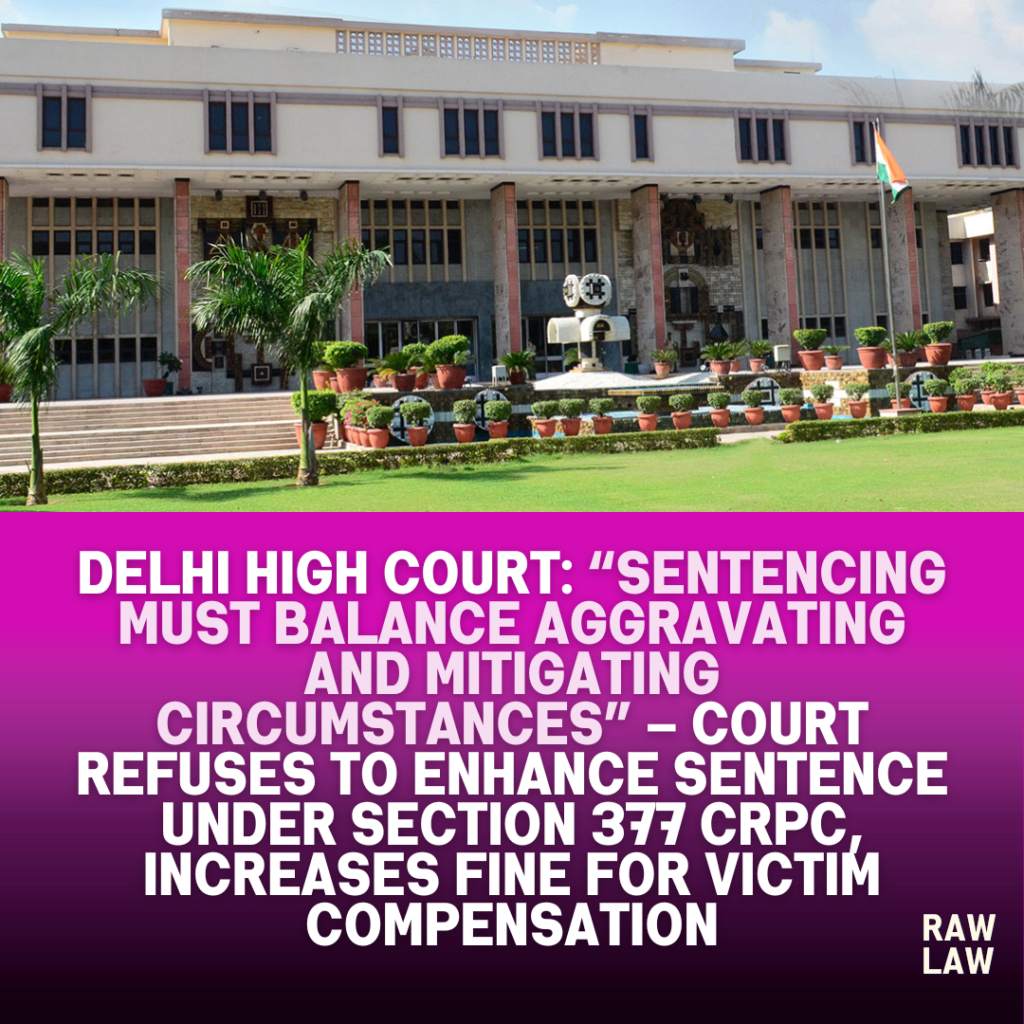Court’s Decision
The Delhi High Court disposed of the State’s appeal under Section 377 of the Code of Criminal Procedure (CrPC), which sought enhancement of the sentence imposed on the respondent. While rejecting the prayer for enhancement of imprisonment, the Court directed an additional fine of ₹20,000 to be paid to the victims, over and above the ₹1 lakh fine already imposed by the trial court. The Court emphasized:
“A just and appropriate sentence has to be determined by balancing aggravating and mitigating factors; neither factor alone can be determinative.”
MAHESH
Facts
The case originated from a 2003 incident at a factory in New Usmanpur, Delhi, where two groups were quarrelling. During the altercation, the father of the respondent, Khem Chand, was pushed by the deceased, Raj Kumar, sustaining a head injury. Angered, Khem Chand exhorted his son, declaring that “Aaj inme se ek aadmi ko thikane lagana padega.” Acting on this, the respondent stabbed Raj Kumar in the thigh with a knife. The injury proved fatal.
The respondent was convicted by the trial court under Section 304(II) IPC and sentenced to rigorous imprisonment (RI) for two years, seven months, and eight days, which he had already undergone during trial. He was also fined ₹1 lakh, with ₹70,000 payable to the victims as compensation and ₹30,000 to the Kerala Flood Relief Fund.
The State appealed under Section 377 CrPC, seeking enhancement of the sentence, contending it was grossly inadequate for causing death.
Issues
- Whether the sentence of 2 years 7 months 8 days already undergone by the respondent for conviction under Section 304(II) IPC was inadequate.
- Whether the mitigating circumstances justified refusal to enhance imprisonment.
- How courts should balance aggravating and mitigating factors in sentencing under the principle of proportionality.
Petitioner’s Arguments
The State argued that the respondent had been found guilty of culpable homicide, and the loss of life warranted a stricter sentence. It emphasized that eyewitnesses corroborated the prosecution’s version and the post-mortem attributed death to the knife wound inflicted by the respondent. Given the seriousness of the offence, the trial court’s sentence was disproportionate and grossly inadequate.
Respondent’s Arguments
The defence accepted the conviction but opposed enhancement of sentence. They argued that the respondent had already spent more than two and a half years in incarceration, and considering the incident was unpremeditated, the punishment was proportionate. The defence highlighted his personal circumstances: aged 49, suffering from acute asthma, working as an ambulance driver, and supporting three minor children. They further stressed the absence of repeated blows and lack of intent to kill.
To support their case, reliance was placed on State of Madhya Pradesh v. Suresh (2019) 14 SCC 151, where the Supreme Court elaborated on balancing factors in sentencing. The respondent also volunteered to pay an additional fine of ₹20,000 to the victims.
Analysis of the Law
The Court reiterated that sentencing under criminal law is guided by the principle of proportionality, requiring careful balancing of aggravating and mitigating circumstances. It emphasized that deterrence, correction, and societal protection must all inform sentencing, while considering the convict’s circumstances.
The Court referred to State of MP v. Suresh where the Supreme Court underscored that no straitjacket formula exists for sentencing. Courts must adopt a holistic view, ensuring punishment is commensurate with both crime and circumstances. Passage of time, mitigating factors, and the convict’s rehabilitation must be weighed against the gravity of the offence and societal demand for justice.
Precedent Analysis
- State of MP v. Suresh (2019) 14 SCC 151 – Applied. The Supreme Court clarified that sentencing requires balancing both aggravating and mitigating factors and stressed proportionality.
- Broader sentencing jurisprudence – The Court drew on established principles that while deterrence is important, rehabilitation and personal circumstances cannot be overlooked, especially when offences lack premeditation.
Court’s Reasoning
The Court observed that the act was not premeditated; it arose from a sudden quarrel. The respondent inflicted a single blow to the thigh, not repeated or targeted at vital organs, suggesting absence of intention to kill, though knowledge of likely consequences existed.
The Court gave weight to mitigating factors: the long pendency of the trial since 2012, the convict’s health condition, and his family responsibilities. No further criminal antecedents were reported. Balancing these against the gravity of the crime, the Court held that enhancement of imprisonment was unnecessary.
However, to address the loss suffered by the victims, the Court enhanced the fine by ₹20,000, to be paid within two months, directing it to be disbursed to the victims.
Conclusion
The appeal by the State was disposed of with modification. The High Court declined to enhance the imprisonment but ordered the respondent to pay an additional ₹20,000 as victim compensation, in line with principles of justice and proportional sentencing.
Implications
This judgment reinforces the principle that sentencing is not a mechanical exercise but requires balancing all circumstances. It highlights that unpremeditated acts resulting in culpable homicide under Section 304(II) IPC can attract lesser sentences when mitigating factors strongly outweigh aggravating ones. Importantly, it stresses victim compensation as a meaningful alternative when imprisonment is considered sufficient.
FAQs
1. Why did the Court refuse to enhance the sentence despite culpable homicide?
Because the act was unpremeditated, involved a single blow, and mitigating factors such as health issues and family responsibilities justified the sentence already undergone.
2. How did the Court address the victims’ interests?
By enhancing the fine by ₹20,000, directing the amount to be paid to the victims as compensation.
3. What principle governs sentencing in such cases?
The principle of proportionality, requiring courts to balance aggravating and mitigating factors while ensuring justice to both the convict and the victims.
